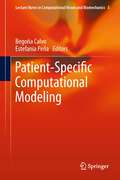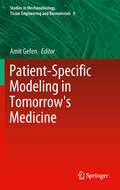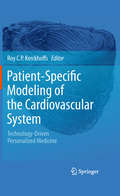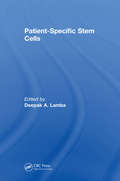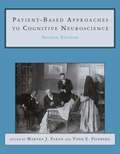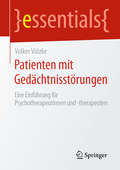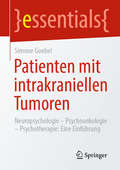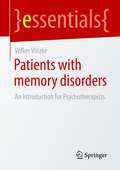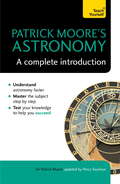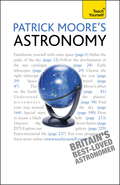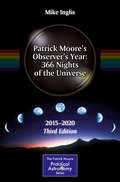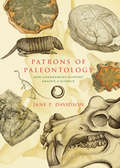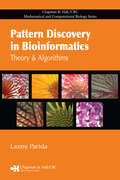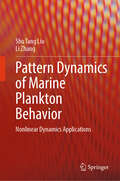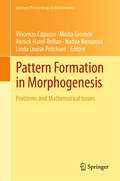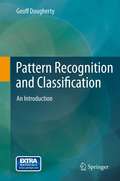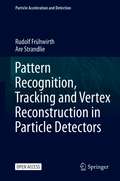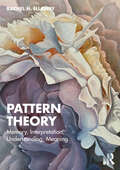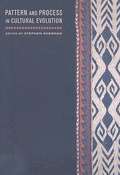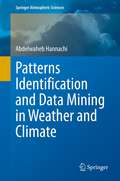- Table View
- List View
Patient-Specific Computational Modeling
by Begoña Calvo Lopez Estefanía PeñaThis book addresses patient-specific modeling. It integrates computational modeling, experimental procedures, imagine clinical segmentation and mesh generation with the finite element method (FEM) to solve problems in computational biomedicine and bioengineering. Specific areas of interest include cardiovascular problems, ocular and muscular systems and soft tissue modeling. Patient-specific modeling has been the subject of serious research over the last seven years and interest in the area is continually growing and this area is expected to further develop in the near future.
Patient-Specific Modeling in Tomorrow's Medicine
by Amit GefenThis book reviews the frontier of research and clinical applications of Patient Specific Modeling, and provides a state-of-the-art update as well as perspectives on future directions in this exciting field. The book is useful for medical physicists, biomedical engineers and other engineers who are interested in the science and technology aspects of Patient Specific Modeling, as well as for radiologists and other medical specialists who wish to be updated about the state of implementation.
Patient-Specific Modeling of the Cardiovascular System
by Roy C.P. KerckhoffsThe main purpose of the book is to demonstrate the design of a variety of patient-specific models within the cardiovascular system in computational biology. The maturation of computational biology could lead to a new approach to medicine. During the last five to ten years, there have been many improvements in diagnostic medical technologies such as multi-slice cardiac CT imaging, 3-D electroanatomic mapping, and many types of applications of Magnetic Resonance Imaging (i.e. magnetic resonance tagging and diffusion tensor imaging). Combined with more powerful computing resources and more accurate predictive computational models it is feasible to begin developing mechanistic patient-specific models that may help diagnosis, guide therapy or surgery, and predict outcomes of the latter. Many questions need to be answered before computational modeling can be fully integrated with standard care, such as what is the minimal data set needed from the patient in order to build a reliable predictive model? What accuracy is needed? How will the initial baseline model be validated? What are reasonable computation times? Is some type of perturbation of the patient's physiology necessary? How could they be integrated with current practices? Are physicians willing to accept these models? These questions will also serve as guidelines throughout the chapters. The book will try to cover, such as cardiac electrophysiology, cardiac (muscle) mechanics, circulation dynamics, arterial and venous flow, angiogenesis, remodeling, metabolism, or combinations between these such as cardiac electromechanics or fluid-solid interactions.
Patient-Specific Stem Cells
by Deepak A. LambaOne of the biggest challenges faced in medical research had been to create accurate and relevant models of human disease. A number of good animal models have been developed to understand the pathophysiology. However, not all of them reflect the human disorder, a classic case being Usher’s syndrome where the mutant mice do not have the same visual and auditory defects that patients face. There are others which have been even more difficult to model due to the multi-factorial nature of the condition and due to lack of discovery of a single causative gene such as age-related macular degeneration or Alzheimer’s syndrome. Thus a more relevant and accurate system will allow us to make better predictions on relevant therapeutic approaches. <P><P>The discovery of human pluripotent stem cells in 1998 followed by the technological advances to reprogram somatic cells to pluripotent-stem cell-like cells in 2006 has completely revolutionized the way we can now think about modelling human development and disease. This now coupled with genome editing technologies such as TALENS and CRISPRs have now set us up to develop in vitro models both 2D as well as 3D organoids, which can more precisely reflect the disease in the patients. These combinatorial technologies are already providing us with better tools and therapeutics in drug discovery or gene therapy. <P><P>This book summarizes both the technological advances in the field of generation of patient specific lines as well as various gene editing approaches followed by its applicability in various systems. The book will serve as a reference for the current state of the field as it: <li>Provides a comprehensive overview of the status of the field of patients derived induced pluripotent stem cells. <li>Describes the use of cardiac cells as a main featured component within the book. <li>Examines drug toxicity analysis as a working example throughout the book.
Patient-based Approaches to Cognitive Neuroscience (2nd edition)
by Martha J. Farah Todd E. FeinbergIn addition to the updated coverage of perception, attention, memory, language, executive function, and development, the new edition includes expanded material on functional neuroimaging of normal subjects and of neurological patients, electrophysiological methods including TMS, and the genetics of neurocognitive disorders.
Patienten mit Gedächtnisstörungen: Eine Einführung für Psychotherapeutinnen und -therapeuten (essentials)
by Volker VölzkeGedächtnisstörungen im Alltag beeinträchtigen die Lebensqualität der Betroffenen und haben auch Auswirkungen auf die therapeutische Vorgehensweise. Kenntnisse zu Diagnostik, Therapie und Kompensation von Gedächtnisstörungen unterschiedlicher Verursachung verbessern die therapeutischen Möglichkeiten in bedeutsamer Weise. Volker Völzke vermittelt in diesem essential praxisbezogenes Basiswissen: Welche Diagnostik und welche Hilfsmittel gibt es und was bedeuten die Gedächtnisdefizite für die Therapie und Beratung? Kann eine Psychotherapie mit Menschen mit Gedächtnisstörungen überhaupt erfolgreich durchgeführt werden? Wie können Personen, die Patienten mit Gedächtnisstörungen versorgen, qualifiziert unterstützt und beraten werden?
Patienten mit intrakraniellen Tumoren: Neuropsychologie – Psychoonkologie – Psychotherapie: Eine Einführung (essentials)
by Simone GoebelDieses essential gibt einen Kurzüberblick über psychosoziale Aspekte von Patienten mit Hirntumoren. Die Arbeit mit dieser besonderen Patientengruppe erfordert spezifische Kenntnisse in den Bereichen Neuropsychologie, Psychoonkologie und Psychotherapie, die praxisnah vermittelt werden. Patienten mit intrakraniellen Tumoren zählen zu den am stärksten belasteten Patientengruppen überhaupt. Sie sind nicht nur von allen Belastungsfaktoren onkologischer Erkrankungen betroffen, zu welchen zum Beispiel die langwierige und nebenwirkungsreiche medizinische Therapie oder die oft verringerte Lebenserwartung zählen, sondern auch von allen Belastungsfaktoren neurologischer Erkrankungen, worunter auch neuropsychologische Veränderungen wie kognitive Defizite, eine verminderte Kommunikationsfähigkeit und organisch bedingte Persönlichkeitsveränderungen fallen.
Patients with Memory Disorders: An Introduction for Psychotherapists (essentials)
by Volker VölzkeMemory disorders in everyday life impair the quality of life of those affected and also have an impact on the therapeutic approach. Knowledge of the diagnosis, therapy and compensation of memory disorders of various causes significantly improves the therapeutic options. Volker Völzke imparts in this essential practice-related basic knowledge: What diagnostics and what tools are available and what do memory deficits mean for therapy and counselling? Can psychotherapy with people with memory disorders be carried out successfully at all? How can people who care for patients with memory disorders be given qualified support and advice?
Patrick Moore's Astronomy: A Complete Introduction: Teach Yourself
by Percy Seymour Sir Patrick MooreAstronomy: A Complete Introduction will ensure you recognize what you are seeing in the night sky. You will investigate the sun, moon, planets comets and stars and learn how to observe them. This comprehensive guide, complete with star charts, will map out the skies and allow you to impress your friends with your knowledge of the sky at night.Astronomy: A Complete Introduction includes:Chapter 1: Introducing AstronomyChapter 2: The spinning skyChapter 3: Sky-watchersChapter 4: The astronomer's telescopeChapter 5: Into spaceChapter 6: The SunChapter 7: The MoonChapter 8: The Sun's familyChapter 9: The inner planetsChapter 10: The outer planetsChapter 11: Minor members of the Solar SystemChapter 12: The starsChapter 13: Pattern of starsChapter 14: Double and variable starsChapter 15: The life and times of a starChapter 16: The Star-clusters and nebulaeChapter 17: The depths of the universeChapter 18: Into the future - life beyond the Earth
Patrick Moore's Astronomy: Teach Yourself
by Patrick MoorePatrick Moore's Astronomy will ensure you recognize what you are seeing in the night sky. You will investigate the sun, moon, planets comets and stars and learn how to observe them. This comprehensive guide, complete with star charts, will map out the skies and allow you to impress your friends with your knowledge of the sky at night.NOT GOT MUCH TIME?One, five and ten-minute introductions to key principles to get you started.AUTHOR INSIGHTSLots of instant help with common problems and quick tips for success, based on the author's many years of experience.TEST YOURSELFTests in the book and online to keep track of your progress.EXTEND YOUR KNOWLEDGEExtra online articles at www.teachyourself.com to give you a richer understanding of astronomy.FIVE THINGS TO REMEMBERQuick refreshers to help you remember the key facts.TRY THISInnovative exercises illustrate what you've learnt and how to use it.
Patrick Moore's Astronomy: Teach Yourself
by Patrick Moore Percy SeymourAstronomy: A Complete Introduction will ensure you recognize what you are seeing in the night sky. You will investigate the sun, moon, planets comets and stars and learn how to observe them. This comprehensive guide, complete with star charts, will map out the skies and allow you to impress your friends with your knowledge of the sky at night. Astronomy: A Complete Introduction includes: Chapter 1: Introducing Astronomy Chapter 2: The spinning sky Chapter 3: Sky-watchers Chapter 4: The astronomer's telescope Chapter 5: Into space Chapter 6: The Sun Chapter 7: The Moon Chapter 8: The Sun's family Chapter 9: The inner planets Chapter 10: The outer planets Chapter 11: Minor members of the Solar System Chapter 12: The stars Chapter 13: Pattern of stars Chapter 14: Double and variable stars Chapter 15: The life and times of a star Chapter 16: The Star-clusters and nebulae Chapter 17: The depths of the universe Chapter 18: Into the future - life beyond the Earth
Patrick Moore's Observer's Year: 366 Nights of the Universe
by Mike InglisObservers no longer need to wonder what they will turn their attention to each night of the year with this updated text of a beloved favorite from Sir Partick Moore. His night-by-night account of the stars is the best possible guide an observer could ask for, and now includes the latest data for the years 2015-2020, preserving and extending Sir Patrick Moore's legacy. This new edition of his classic text makes it easy to see why Sir Patrick Moore was such a helpful guide to generations of budding astronomers, professional and amateur alike. For every night of the year Patrick gives the reader details of interesting objects that can be seen from Earth. It is a book for people with a wide interest in practical astronomy, those who may not have specialized in a specific area of astronomy and wish to expand their knowledge in all areas. Moore updated his book in a second edition in 2005, giving astronomical events through 2010, but a more current version has been desperately lacking. This third edition includes Sir Patrick's original text but revises its time-sensitive material and adds all of the points of interest that change from year to year, such as eclipses, occultations, planetary positions, and so on. Sir Patrick Moore left behind an enormous legacy, including the world's longest-running television series with the same original presenter, the BBC's The Sky at Night, and more than 70 written works. His influence on the world of amateur astronomy was phenomen al, and his knowledge and passion led many to take up observing as a life-long hobby. This book, "The Observer's Year, 366 Nights of the Universe" was, he said, one of his personal favorites. It now features a tribute to Patrick Moore's legacy as well as including what has changed in astronomy since the previous edition ten years ago.
Patrones Crecientes (Growing Patterns): Los números de Fibonacci en la naturaleza
by Sarah C. CampbellAn ALSC Notable Children's BookA wondrous introduction to one of the most beautiful connections between mathematics and the natural world—the Fibonacci sequence—through a series of stunning nature photographs.Discover the biggest mathematical mystery in nature—Fibonacci numbers! Named after a famous mathematician, the number pattern is simple and starts with: 1, 1, 2, 3, 5, 8, 13. Each number in the sequence comes from adding the two numbers before it. What's the mystery? The pattern crops up in the most unexpected places. You'll find it in the disk of a sunflower, the skin of a pineapple, and the spiral of a nautilus shell. This book brings math to life, celebrates science, and inspires kids to see nature through new eyes.
Patrons of Paleontology: How Government Support Shaped a Science
by Jane P. DavidsonIn the 19th and early 20th centuries, North American and European governments generously funded the discoveries of such famous paleontologists and geologists as Henry de la Beche, William Buckland, Richard Owen, Thomas Hawkins, Edward Drinker Cope, O. C. Marsh, and Charles W. Gilmore. In Patrons of Paleontology, Jane Davidson explores the motivation behind this rush to fund exploration, arguing that eagerness to discover strategic resources like coal deposits was further fueled by patrons who had a genuine passion for paleontology and the fascinating creatures that were being unearthed. These early decades of government support shaped the way the discipline grew, creating practices and enabling discoveries that continue to affect paleontology today.
Patrons of Paleontology: How Government Support Shaped a Science (Life of the Past)
by Jane P. DavidsonA history of North American and European governments supporting paleontology in the nineteenth and twentieth centuries, and the motivation behind it.In the nineteenth and early twentieth centuries, North American and European governments generously funded the discoveries of such famous paleontologists and geologists as Henry de la Beche, William Buckland, Richard Owen, Thomas Hawkins, Edward Drinker Cope, O. C. Marsh, and Charles W. Gilmore. In Patrons of Paleontology, Jane Davidson explores the motivation behind this rush to fund exploration, arguing that eagerness to discover strategic resources like coal deposits was further fueled by patrons who had a genuine passion for paleontology and the fascinating creatures that were being unearthed. These early decades of government support shaped the way the discipline grew, creating practices and enabling discoveries that continue to affect paleontology today.“This slim book, graced with beautiful facsimile reproductions of gorgeous paleontological folio art, is a treasure trove of vertebrate paleontological history, sacred and arcane.” —The Quarterly Review of Biology“Patrons of Paleontology is a good introduction to the ambitious individuals and institutions that pursued their own, national, and institutional interests over centuries in a variety of contexts.” —Journal of American History“Who pays for palaeontological research and why? Patrons of Paleontology will be a useful reference guide for anyone interested in the early history of the subject and some of the social and historical context in which it occurred.” —Paul Barrett, Priscum, The Newsletter of the Palentological Society
Pattern Discovery in Bioinformatics: Theory & Algorithms
by Laxmi ParidaThe computational methods of bioinformatics are being used more and more to process the large volume of current biological data. Promoting an understanding of the underlying biology that produces this data, Pattern Discovery in Bioinformatics: Theory and Algorithms provides the tools to study regularities in biological data.Taking a systema
Pattern Dynamics of Marine Plankton Behavior: Nonlinear Dynamics Applications
by Li Zhang Shu Tang LiuTo ultimately address this serious issue, this book begins with the nonlinear dynamic characteristics of marine plankton, focusing on the dynamic behavior of both two-dimensional and spatiotemporal patterns. As a critical foundation of marine ecosystems, the frequent outbreaks of marine phytoplankton and the toxicity of planktonic animals pose significant threats to marine ecological security and human health. One of the primary reasons we currently struggle to effectively manage the safety issues surrounding marine plankton is the extremely complex nature of their growth environment, which exhibits intricate dynamic and nonlinear characteristics. By constructing reaction-diffusion models and fractional diffusion systems of the planktonic ecosystem, the book characterizes the various factors in different environments and studies the nonlinear behavior of marine organisms. Employing linear stability theory, multi-scale analysis, comparison principle, analytical techniques, and the construction of Lyapunov functions, the book delves into the following topic: the stability of the plankton ecosystem, Hopf bifurcation, Turing bifurcation and other local bifurcations, spatial self-organization behavior of marine plankton, the formation of spatiotemporal patterns, and the persistence and extinction properties and characteristics. Marine ecology and the marine environment are currently hot research topics internationally, with the behavior of marine organisms being a core area of this research. The goal of exploring these issues is to scientifically understand the features of marine organisms, control their behavior, manage ocean pollution effectively, contribute to human development, and support social advancement. Additionally, the authors aime to make academic contributions and provide guidance to graduate students and researchers dedicated to this field.
Pattern Formation and Dynamics in Nonequilibrium Systems
by Michael Cross Henry GreensideMany exciting frontiers of science and engineering require understanding the spatiotemporal properties of sustained nonequilibrium systems such as fluids, plasmas, reacting and diffusing chemicals, crystals solidifying from a melt, heart muscle, and networks of excitable neurons in brains. This introductory textbook for graduate students in biology, chemistry, engineering, mathematics, and physics provides a systematic account of the basic science common to these diverse areas. This book provides a careful pedagogical motivation of key concepts, discusses why diverse nonequilibrium systems often show similar patterns and dynamics, and gives a balanced discussion of the role of experiments, simulation, and analytics. It contains numerous worked examples and over 150 exercises. This book will also interest scientists who want to learn about the experiments, simulations, and theory that explain how complex patterns form in sustained nonequilibrium systems.
Pattern Formation in Morphogenesis
by Vincenzo Capasso Annick Harel-Bellan Misha Gromov Linda Louise Pritchard Nadya MorozovaPattern Formation in Morphogenesis is a rich source of interesting and challenging mathematical problems. The volume aims at showing how a combination of new discoveries in developmental biology and associated modelling and computational techniques has stimulated or may stimulate relevant advances in the field. Finally it aims at facilitating the process of unfolding a mutual recognition between Biologists and Mathematicians of their complementary skills, to the point where the resulting synergy generates new and novel discoveries. It offers an interdisciplinary interaction space between biologists from embryology, genetics and molecular biology who present their own work in the perspective of the advancement of their specific fields, and mathematicians who propose solutions based on the knowledge grasped from biologists.
Pattern Recognition and Classification
by Geoff DoughertyThe use of pattern recognition and classification is fundamental to many of the automated electronic systems in use today. However, despite the existence of a number of notable books in the field, the subject remains very challenging, especially for the beginner. Pattern Recognition and Classification presents a comprehensive introduction to the core concepts involved in automated pattern recognition. It is designed to be accessible to newcomers from varied backgrounds, but it will also be useful to researchers and professionals in image and signal processing and analysis, and in computer vision. Fundamental concepts of supervised and unsupervised classification are presented in an informal, rather than axiomatic, treatment so that the reader can quickly acquire the necessary background for applying the concepts to real problems. More advanced topics, such as semi-supervised classification, combining clustering algorithms and relevance feedback are addressed in the later chapters. This book is suitable for undergraduates and graduates studying pattern recognition and machine learning.
Pattern Recognition, Tracking and Vertex Reconstruction in Particle Detectors (Particle Acceleration and Detection)
by Rudolf Frühwirth Are StrandlieThis open access book is a comprehensive review of the methods and algorithms that are used in the reconstruction of events recorded by past, running and planned experiments at particle accelerators such as the LHC, SuperKEKB and FAIR. The main topics are pattern recognition for track and vertex finding, solving the equations of motion by analytical or numerical methods, treatment of material effects such as multiple Coulomb scattering and energy loss, and the estimation of track and vertex parameters by statistical algorithms. The material covers both established methods and recent developments in these fields and illustrates them by outlining exemplary solutions developed by selected experiments. The clear presentation enables readers to easily implement the material in a high-level programming language. It also highlights software solutions that are in the public domain whenever possible. It is a valuable resource for PhD students and researchers working on online or offline reconstruction for their experiments.
Pattern Theory: Memory, Interpretation, Understanding, Meaning
by Rachel H. EllawayPattern Theory is a groundbreaking exploration of the concept of pattern across a range of disciplines, including science, neuroscience, psychology, and social sciences.This book examines the meaning and implications of pattern, presenting a comprehensive body of theory that unifies concepts of form, order, and regularity and connects them to memory and perception. By challenging existing orthodoxies and linking evidence from brain and mind function, it outlines a robust theoretical framework around pattern searching and matching, pattern activation, and the continuity of pattern nexuses. This in-depth study of pattern theory and pattern thinking delves into the cognitive basis of patterns, their impact on reasoning and learning, and the social and collaborative nature of pattern recognition, expression, and representation. It also addresses philosophical issues and implications surrounding shared pattern thinking and introduces a broad conceptual basis for "pattern inquiry", providing a range of questions and methodologies for applying pattern theory. The book culminates in a manifesto for pattern theory and its application in pattern inquiry, offering 50 key principles that can be applied across various settings. Researchers, scholars, and practitioners are encouraged to explore and critique this unified theory as a lens for examining social and cognitive phenomena.Ideal for academics and professionals seeking to challenge their understanding of the connections between mind and society, as well as for those looking to deepen their understanding of pattern as a cognitive phenomenon, as a theoretical lens, and as a meta-methodology for inquiry, this text provides a substantive foundation for ongoing development and application of pattern science across multiple fields.
Pattern and Process in Cultural Evolution
by Stephen ShennanThis volume offers an integrative approach to the application of evolutionary theory in studies of cultural transmission and social evolution and reveals the enormous range of ways in which Darwinian ideas can lead to productive empirical research, the touchstone of any worthwhile theoretical perspective. While many recent works on cultural evolution adopt a specific theoretical framework, such as dual inheritance theory or human behavioral ecology,Pattern and Process in Cultural Evolution emphasizes empirical analysis and includes authors who employ a range of backgrounds and methods to address aspects of culture from an evolutionary perspective. Editor Stephen Shennan has assembled archaeologists, evolutionary theorists, and ethnographers, whose essays cover a broad range of time periods, localities, cultural groups, and artifacts.
Patterns Identification and Data Mining in Weather and Climate (Springer Atmospheric Sciences)
by Abdelwaheb HannachiAdvances in computer power and observing systems has led to the generation and accumulation of large scale weather & climate data begging for exploration and analysis. Pattern Identification and Data Mining in Weather and Climate presents, from different perspectives, most available, novel and conventional, approaches used to analyze multivariate time series in climate science to identify patterns of variability, teleconnections, and reduce dimensionality. The book discusses different methods to identify patterns of spatiotemporal fields. The book also presents machine learning with a particular focus on the main methods used in climate science. Applications to atmospheric and oceanographic data are also presented and discussed in most chapters. To help guide students and beginners in the field of weather & climate data analysis, basic Matlab skeleton codes are given is some chapters, complemented with a list of software links toward the end of the text. A number of technical appendices are also provided, making the text particularly suitable for didactic purposes.The topic of EOFs and associated pattern identification in space-time data sets has gone through an extraordinary fast development, both in terms of new insights and the breadth of applications. We welcome this text by Abdel Hannachi who not only has a deep insight in the field but has himself made several contributions to new developments in the last 15 years. - Huug van den Dool, Climate Prediction Center, NCEP, College Park, MD, U.S.A.Now that weather and climate science is producing ever larger and richer data sets, the topic of pattern extraction and interpretation has become an essential part. This book provides an up to date overview of the latest techniques and developments in this area. - Maarten Ambaum, Department of Meteorology, University of Reading, U.K.This nicely and expertly written book covers a lot of ground, ranging from classical linear pattern identification techniques to more modern machine learning, illustrated with examples from weather & climate science. It will be very valuable both as a tutorial for graduate and postgraduate students and as a reference text for researchers and practitioners in the field. - Frank Kwasniok, College of Engineering, University of Exeter, U.K.
